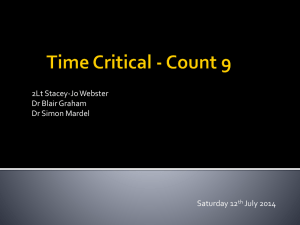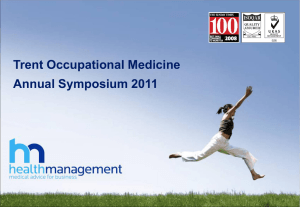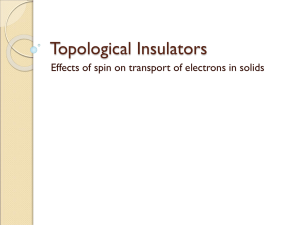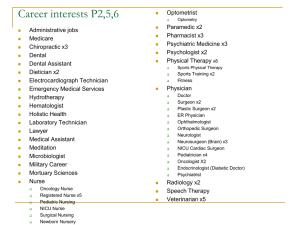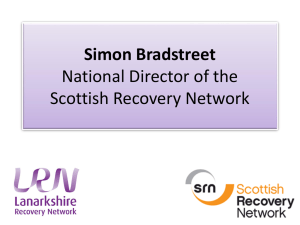ppt
advertisement
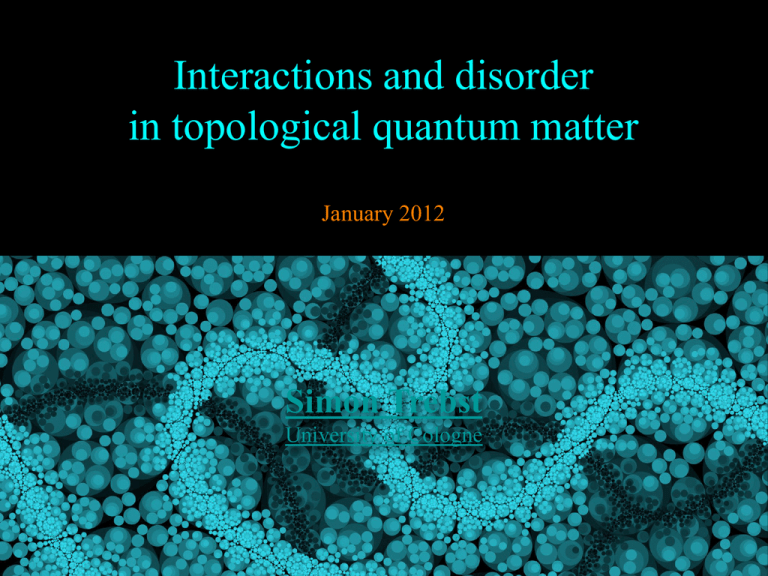
Interactions and disorder in topological quantum matter January 2012 Simon Trebst University of Cologne © Simon Trebst Overview Topological quantum matter Interactions Disorder Experimental signatures © Simon Trebst Topological quantum matter The interplay between physics and topology takes its first roots in the 1860s. The mathematician Peter Tait sets out to perform experimental studies. © Simon Trebst Topological quantum matter • 1867: Lord Kelvin atoms = knotted tubes of ether Knots might explain stability, variety, vibrations, ... • Maxwell: “It satisfies more of the conditions than any atom hitherto imagined.” • This inspires the mathematician Tait to classify knots. © Simon Trebst Non-topological (quantum) matter © Simon Trebst Topological quantum matter • Xiao-Gang Wen: A ground state of a many-body system that cannot be fully characterized by a local order parameter. • A ground state of a many-body system that cannot be transformed to “simple phases” via local perturbations without going through phase transitions. • Often characterized by a variety of “topological properties”. © Simon Trebst Topological matter / classification (rough) Topological order inherent symmetry protected Gapped phases that cannot be transformed – without closing the bulk gap – to “simple phases” via any “paths” Gapped phases that cannot be transformed – without closing the bulk gap – to “simple phases” via any symmetry preserving “paths”. quantum Hall states spin liquids topological band insulators © Simon Trebst Quantum Hall effect Quantization of conductivity for a two-dimensional electron gas at very low temperatures in a high magnetic field. B I electron gas V AlGaAs electron gas GaAs AlGaAs Semiconductor heterostructure confines electron gas to two spatial dimensions. © Simon Trebst Quantum Hall states Landau levels B edge states Landau level degeneracy integer quantum Hall fractional quantum Hall filled level partially filled level Coulomb repulsion orbital states © Simon Trebst incompressible liquid incompressible liquid Fractional quantum Hall states “Pfaffian” state Moore & Read (1994) Charge e/4 quasiparticles Ising anyons SU(2)2 Nayak & Wilzcek (1996) “Parafermion” state Read & Rezayi (1999) Charge e/5 quasiparticles Fibonacci anyons SU(2)3 Slingerland & Bais (2001) J.S. Xia et al., PRL (2004) © Simon Trebst px+ipy superconductors px+ipy superconductor vortex possible realizations Sr2RuO4 p-wave superfluid of cold atoms A1 phase of 3He films fermion Topological properties of px+ipy superconductors Read & Green (2000) Vortices carry characteristic “zero mode” 2N vortices give degeneracy of 2N. © Simon Trebst SU(2)2 Topological Insulators 2D – HgTe quantum wells © Simon Trebst 3D – Bi2Se3 Proximity effects / heterostructures Proximity effect s-wave superconductor topological insulator © Simon Trebst Proximity effect between an s-wave superconductor and the surface states of a (strong) topological insulator induces exotic vortex statistics in the superconductor. Spinless px+ipy superconductor where vortices bind a zero mode. Vortices, quasiholes, anyons, ... Interactions © Simon Trebst Abelian vs. non-Abelian vortices Consider a set of ‘pinned’ vortices at fixed positions. Abelian non-Abelian single state (degenerate) manifold of states Example: Manifold of states grows exponentially with the number of vortices. Laughlin-wavefunction + quasiholes Ising anyons (Majorana fermions) © Simon Trebst Fibonacci anyons Abelian vs. non-Abelian vortices Consider a set of ‘pinned’ vortices at fixed positions. Abelian non-Abelian single state (degenerate) manifold of states matrix fractional phase In general M and N do not commute! © Simon Trebst Topological quantum computing Topological quantum computing non-Abelian Degenerate manifold = qubit Employ braiding of non-Abelian vortices to perform computing (unitary transformations). time (degenerate) manifold of states matrix In general M and N do not commute! © Simon Trebst Vortex-vortex interactions exponential decay vortex separation RKKY-like oscillation © Simon Trebst Vortex-vortex interactions exponential decay vortex separation RKKY-like oscillation © Simon Trebst middle of plateau edge of plateau Vortex-vortex interactions Vortex quantum numbers Vortex pair SU(2)k = ‘deformation’ of SU(2) with finite set of representations © Simon Trebst fusion rules Energetics for many vortices example k = 2 “Heisenberg Hamiltonian” for vortices Vortex-vortex interactions Microscopics Vortex pair Which channel is favored is not universal, but microscopic detail. p-wave SC, Kitaev model Energetics for many vortices vortex separation Moore-Read state “Heisenberg Hamiltonian” for vortices © Simon Trebst The many-vortex problem quantum liquid quantum liquid new quantum liquid a vortex-vortex interactions macroscopic degeneracy © Simon Trebst unique ground state The collective state quantum liquid quantum liquid bulk gap SU(2)k-1 SU(2)k U(1) © Simon Trebst Edge states Finite-size gap conformal field theory description © Simon Trebst Entanglement entropy central charge Mapping & exact solution The operators form a representation of the Temperley-Lieb algebra for The transfer matrix is an integrable representation of the RSOS model. © Simon Trebst Gapless theories level k 2 3 4 5 k ∞ © Simon Trebst ‘antiferromagnetic’ ‘ferromagnetic’ Ising Ising c = 1/2 c = 1/2 tricritical Ising 3-state Potts c = 7/10 c = 4/5 tetracritical Ising c = 4/5 pentacritical Ising c = 6/7 c=1 c = 8/7 k-critical Ising Zk-parafermions c = 1-6/(k+1)(k+2) c = 2(k-1)/(k+2) Heisenberg AFM Heisenberg FM c=1 c=2 Gapless modes & edge states SU(2)k liquid critical theory (AFM couplings) interactions SU(2)k liquid gapless modes = edge states nucleated liquid © Simon Trebst Interactions + disorder Work done with Chris Laumann (Harvard) David Huse (Princeton) Andreas Ludwig (UCSB) arXiv:1106.6265 © Simon Trebst Disorder induced phase transition quantum liquid thermal metal a disorder + vortex-vortex interactions macroscopic degeneracy © Simon Trebst degeneracy is split Interactions and disorder quantum liquid a sign disorder + strong amplitude modulation Natural analytical tool: strong-randomness RG separation a © Simon Trebst Unfortunately, this does not work. The system flows away from strong disorder under the RG. No infinite randomness fixed point. From Ising anyons to Majorana fermions Ising anyon SU(2)2 quantum number interacting Ising anyons “anyonic Heisenberg model” © Simon Trebst Majorana fermion zero mode Majorana operator free Majorana fermion hopping model From Ising anyons to Majorana fermions Majorana operators Majorana fermion zero mode Majorana operator free Majorana fermion hopping model © Simon Trebst particle-hole symmetry time-reversal symmetry ✓ ✘ symmetry class D A disorder-driven metal-insulator transition Griffith physics gapped top. phase Chern insulator ν = -1 Griffith physics thermal metal sign disorder gapped top. phase Chern insulator ν = +1 Density of states indicates phase transition. © Simon Trebst Density of states Oscillations in the DOS fit the prediction from random matrix theory for symmetry class D © Simon Trebst The thermal metal Density of states diverges logarithmically at zero energy. © Simon Trebst The thermal metal Inverse participation ratios (moments of the GS wavefunction) indicate multifractal structure characteristic of a metallic state. © Simon Trebst A disorder-driven metal-insulator transition © Simon Trebst Disorder induced phase transition quantum liquid thermal metal a disorder + vortex-vortex interactions macroscopic degeneracy © Simon Trebst degeneracy is split Experimental consequences © Simon Trebst Heat transport middle of plateau Caltech thermopower experiment electrical transport remains unchanged Bulk heat transport diverges logarithmically as T → 0. Heat transport along the sample edges changes quantitatively © Simon Trebst Collective states – a good thing? Topological quantum computing Degenerate manifold = qubit The interaction induced splitting of the degenerate manifold = qubit states is yet another obstacle to overcome. Employ braiding of non-Abelian vortices to perform computing (unitary transformations). time The formation of collective states renders all ideas of manipulating individual anyons inapplicable. Probably, a topological quantum computer works best at finite temperatures. © Simon Trebst Summary • Lord Kelvin was way ahead of his time. • Topology has re-entered physics in many ways. • Topological excitations + interactions + disorder can give rise to a plethora of collective phenomena. • Topological liquid nucleation • Thermal metal • Distinct experimental bulk observable (heat transport) in search for Majorana fermions. © Simon Trebst

